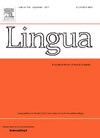南非英语书面语中的规定性、编辑和形态句法变化:有关who、that和which的个案研究
IF 1.3
3区 文学
0 LANGUAGE & LINGUISTICS
引用次数: 0
摘要
在变异论的研究中,很少反思书面文本生产中涉及的多个主体,其独特的语言和规范表征影响着文本的语言构成。在这项研究中,我们询问出版书面语言的统一性和规定性来自哪里——直接来自作者,还是来自那些负责编辑干预的人。关注带有动先行词的主语限制性关系从句中who, that和which之间的交替,我们分析了南非英语三个亚变体中未经编辑的书面文本及其编辑的对应文本的变化模式。我们发现,一般来说,在未编辑的亚变体写作中,相对符号的分布模式与其他英语变体相似,反映了英语相对体系的稳定性。然而,与之前对新英语的研究结果一致,在所调查的亚变体中存在较低水平的分歧,并且,总的来说,与之前专注于书面语言的研究相比,在主语位置的限制性关系从句中使用动画先行词的that和which的比例频率更高。当多样性倾向于较少的原型用法时,编辑干预有时会通过修改使用趋向于更原型的用法来掩盖这一点。然而,干预的模式并不总是一致的。编辑与作者的语言背景(即他们是否使用相同的南非英语亚种)似乎是制约编辑干预的因素之一。本文章由计算机程序翻译,如有差异,请以英文原文为准。
Prescriptivism, editing, and morphosyntactic variation in written South African Englishes: A case study of relative who, that and which
In variationist research there is little reflection on the multiple agents involved in written textual production, whose distinct linguistic and normative representations influence the linguistic composition of a text. In this study, we ask where the uniformity and prescription-oriented nature of published written language originate – directly from writers, or from those responsible for editorial intervention. Focusing on the alternation between who, that and which in subject restrictive relative clauses with animate antecedents, we analyse patterns of variation in unedited written texts and their edited counterparts, across three subvarieties of South African English. We find that, generally, in the unedited writing of the subvarieties the distribution of relativisers patterns similarly to other varieties of English, reflecting the stability of the English relativisation system. However, in line with previous findings on New Englishes, there are lower-level divergences in the subvarieties investigated – and, in general, higher proportional frequencies of that and which with animate antecedents in restrictive relative clauses in subject position than is generally the case in previous studies that have focused on written language. Where a variety tends towards less prototypical usage, editorial interventions at times mask this by amending usage towards more prototypical usage. However, the patterns of intervention are not always consistent. The linguistic background of the editor in relation to that of the author (i.e. whether they are users of the same subvariety of South African English or not) appears to be one of the factors conditioning editorial intervention.
求助全文
通过发布文献求助,成功后即可免费获取论文全文。
去求助
来源期刊

Lingua
Multiple-
CiteScore
2.50
自引率
9.10%
发文量
93
审稿时长
24 weeks
期刊介绍:
Lingua publishes papers of any length, if justified, as well as review articles surveying developments in the various fields of linguistics, and occasional discussions. A considerable number of pages in each issue are devoted to critical book reviews. Lingua also publishes Lingua Franca articles consisting of provocative exchanges expressing strong opinions on central topics in linguistics; The Decade In articles which are educational articles offering the nonspecialist linguist an overview of a given area of study; and Taking up the Gauntlet special issues composed of a set number of papers examining one set of data and exploring whose theory offers the most insight with a minimal set of assumptions and a maximum of arguments.
 求助内容:
求助内容: 应助结果提醒方式:
应助结果提醒方式:


